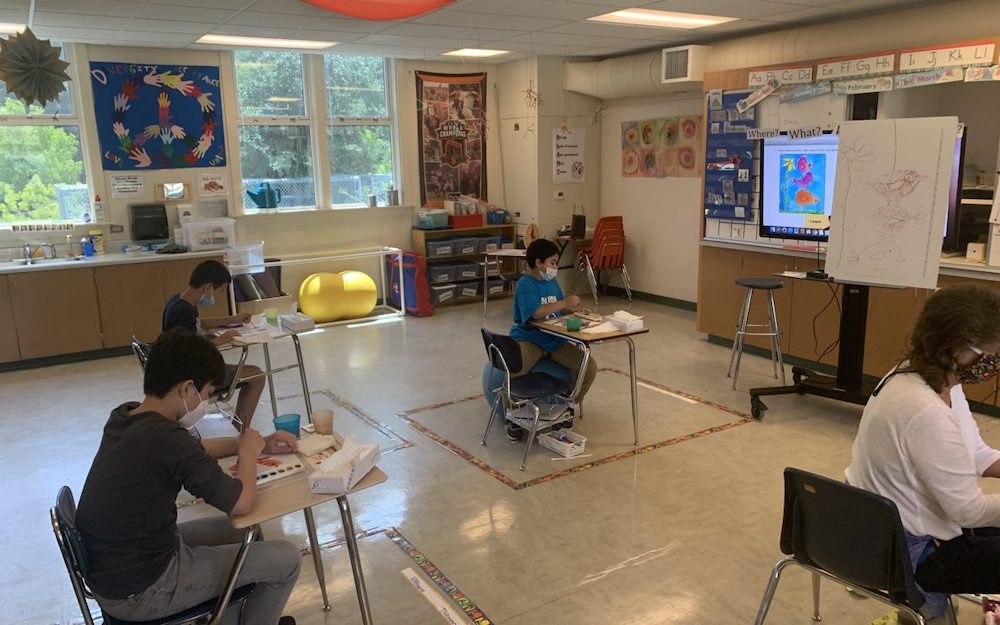The Piedmont Unified School District (PUSD) embarked on a hasty experiment in remote learning in mid-March in response to the campus closures necessitated by the coronavirus pandemic.
Now, two and a half months later as students are logging off their Chromebooks for the summer, the consensus is clear: learning from home cannot replicate the classroom experience.
The Wall Street Journal and the New York Times both ran stories last week outlining the difficulties school districts across the country faced during the shutdown. In the Bay Area, tensions between families and teachers have been running high, as detailed in this reporting from Mill Valley. Locally, more than 300 parents logged in to a May PUSD school board meeting to weigh in on shortcomings and challenges ahead. Piedmont school administrators are keeping all this in mind as they plan for an unpredictable 2020-21 school year.
“Distance learning is a poor substitute for in-person education,” said PUSD Superintendent Randy Booker.
“We’ve been ‘crisis learning’ with teachers teaching from their homes while caring for their children, while trying to stay healthy, while trying to figure out where to get toilet paper,” he said. “What COVID-19 threw at them was impossible.”
When the district shifted to distance learning on March 16, the initial plan was to teach students at home for two weeks, but with longer shelter in place restrictions announced, schools were soon closed for the rest of the year and the district scrambled to implement distance learning through the end of the school.
Community feedback from a district survey in late March, emails and public comment to the PUSD Board of Education, and most recently input logged into the district’s ThoughtExchange online tool, reveal the inadequacy of distance learning. Families experienced wi-fi problems at home, remote teaching did not play to teacher strengths, Schoology was hard to navigate, the pass/no-pass grading policy lessened student motivation. For elementary students, distance learning required more intervention from parents in general and particularly for special education students while many of parents were juggling their own work from home demands.
Some high schoolers simply checked out. The district initially saw a drop-off in participation, with some teens not logging in at all.
According to Booker, through outreach the district was able to account for every student and identify the obstacles to participation they were facing. Some had difficulty accessing Schoology and faced problems accessing the internet from home. Other students were not being truthful about their participation with their parents and saw distance learning as an extended school break. And some reasoned that the district’s distance learning pass/no pass grading policy meant that because they would not be receiving grades, they did not need to participate.
Booker recognizes that students are conditioned to receive grades and that the shift to pass/not pass was a difficult transition for some. “They grumbled that they were not getting grades, and I empathize with them. But at the end of the day, they came around.”
Of the district’s 850 high school students, the district had concerns about 50 students, and teacher outreach proved effective.
“We haven’t seen a huge uptick in students failing or needing remediation. And all seniors passed their classes and walked the stage at graduation,” he said.
An analysis this month by the Collaborative for Student Growth, which is affiliated with the research nonprofit NWEA (a group that creates academic assessments), predicted a substantial impact from the pandemic, estimating a loss of 30 percent of the typical yearly gains in reading and, in some grades, nearly a full year behind in math. According to Booker, assessments will be needed to gauge the academic impact of emergency distance learning on students.
For Booker, dealing with the social and emotional effects of the last few months is equally, if not more important, than the academic impact.
“We’re learning what happens when children are not in an in-person learning environment when teachers have no eye-to-eye contact, can’t read body language, or check in. Not only does distance learning affect the social and emotional health of students, but the teachers as well.”
Piedmont Superintendent Randy Booker
In addition, he is working on ways to address the impact of the killing of George Floyd by Minneapolis police and the resulting social justice movement on students. “There is no way we can return to school and not acknowledge all that has taken place,” said Booker. “If we were in class, we’d be dealing with these issues in person, processing what it means to us as a community.”
A task force of 105 community members – educators, classified staff, elected officials, parents, and students – are currently working to apply what the district has learned from the last 10 weeks of distance learning to the state and local guidelines for safely opening schools in the fall. (State education officials released their recommendations for re-opening schools this week.)
Booker anticipates a hybrid approach to learning that would blend in-person instruction with distance learning while preparing to pivot to all distance learning if the public health situation changes.
An update on the task force’s work and a summary of the ThoughtExchange results will be presented at the June 10 board meeting with a draft learning plan scheduled to be presented on June 24.
You can view the full June 10 School Board agenda here.
